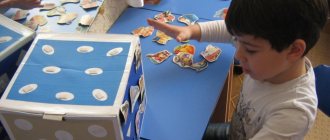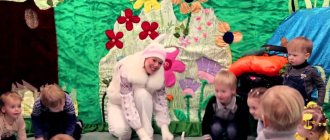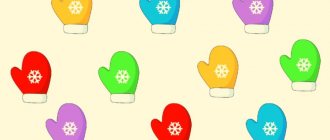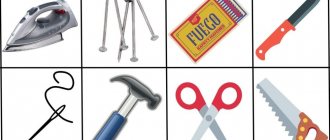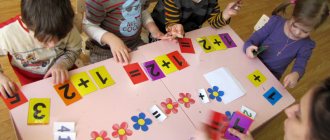Card index of Didactic games for the winter period for children 2-3 years old.
"Pick your buttons"
Objectives: To develop the ability to group objects by size.
Material: 2 boxes, large and small, buttons of different sizes (large and small) Description of the game: The teacher, together with the children, arranges the buttons into groups: the largest, largest, smallest, etc. Considering the sizes of buttons, compares and applies button to button. The adult activates the children's speech.
Topic "Ground transport"
"Cars are coming"
Objectives: Develop the need for communication and interaction, set an example of proper conflict resolution, and form friendly relationships. Follow the rules. When confronted by a partner, you should apologize and give way, otherwise the green signal will not appear.
Game description: The teacher invites the children to go for a ride in the car. Children take an imaginary steering wheel in their hands, give the signal: “Beep!”, and drive, imitating the noise of the car: “Zh-zh-zh” - to the music corresponding to the nature of the game. The teacher raises a red circle and loudly announces: the passage is closed. Children are waiting for a signal. The teacher raises the green circle and says: you can go. The children move on.
Then the teacher sits the children on chairs and uses toys to show them the play “Stubborn.”
Two cars are driving along a bridge and suddenly collide with each other. One driver (the goat) asks the other (the lamb) to give way to him, but the first driver does not want to give way. The drivers go out onto the bridge, argue, butt heads and fall into the river.
The teacher asks questions: “What happened to the cars? Who drove these cars? How did the lamb and the goat argue? What happened to them then?
After the performance, the teacher again invites the children to ride in cars. Children “drivers” should not crowd on the roads, look at the traffic lights, listen to the signal: stop or drive. If the “cars” collide, the teacher shows a yellow circle (“dispute”). The drivers say to each other: “Sorry, pass,” and one gives way to the other.
The teacher specifically stops the “machines” that collide and gives them the opportunity to resolve the dispute. After resolving each controversial situation, he comes to the conclusion: we must live together, give in to each other.
"Train"
Objectives: to help children adapt to the conditions of kindergarten, create a positive emotional climate in the group; relieving emotional stress; encourage children to interact with each other. practicing basic movements - running, walking. Description of the game: The teacher suggests playing “train”: “I am the locomotive, and you are the carriages.” Children stand in a column one after another, holding onto the clothes of the person in front. “Let’s go,” says the adult, and everyone begins to move, saying: “Choo-chu-chu.” The teacher drives the train in one direction, then in the other, then slows down, stops and says: “Stop.” After some time, the train sets off again.
Material on the topic Winter for middle group preschoolers
Thematic material for the middle group.
Lexical topic: “Winter entertainment.” Description of the material : I offer you a selection of methodological and didactic material for planning work with children of the middle group on the topic “Winter fun”.
The development will be of interest to preschool teachers. Didactic games:
“Choose the word” Purpose: to teach children to answer questions. Move. The teacher asks the children questions: - What is winter like? (Cold, snowy, frosty...) -What kind of snow is there in winter? (Cold, sticky, crumbly, white...) -What kind of snowflakes? (Small, white, snowflakes - fluff, cold...) - What is the sky like in winter? (Grey, gloomy...) - What is the sun like in winter? (It doesn’t warm up at all, it rarely appears...) - What kind of clouds? (Look out the window...) - What kind of snowdrifts? (Large, white, snowy like mountains...) - What kind of wind? (Cold, icy...) “What happens in winter?” Conducted similarly to the game “What Happens in Autumn?” Goal: to consolidate the concept of winter phenomena, to activate the vocabulary on the topic. Equipment: story pictures depicting different seasons. Move. On the table are mixed pictures depicting various seasonal phenomena (it is snowing, a flowering meadow, an autumn forest, a starling in a birdhouse, etc.). The child chooses pictures that depict only winter phenomena and names them himself or with the help of an adult. Example. Snowing. There are no leaves on the trees. The river is frozen. Cold. People wear warm clothes. Children skate and ski. “A little white snow fell” Purpose: to clarify and expand the vocabulary on the topic, to learn to coordinate words with movement. Equipment: real snow and icicles. Move. An adult brings home snow and icicles of various sizes. Reviews them together with the child. The adult activates the child’s speech with questions: “What color is the snow? (white) What kind of icicle? (transparent) What do they feel like? (cold, soft snow, hard icicle).” Watch how the snow and icicle melt and turn into water. Then the observation continues on the street or from a window. The child answers the adult’s questions: “What is on the ground? What kind of snow? What's hanging under the roof? What icicle?” After this, the adult offers the child to warm up, since it is cold outside. They will sing a poem, performing with the child all the movements corresponding to the text: A little white snow fell - We all gathered in a circle, We will tread, we will tread, We will dance merrily, We will warm our hands. We will clap, we will clap To make it more fun for us, We will jump faster. We'll jump, we'll jump, "What's too much?" Goal: expand and activate the vocabulary on the topic. Equipment: pictures depicting objects for games at different times of the year or real objects (sled, ball, shovel, skates, bicycle, skis, paper boat, jump rope, etc.), a plot picture on the topic “Winter fun”. Move. The adult invites the child to select and name only those items that are necessary for winter games. Unnecessary items are removed. If he finds it difficult, an adult helps him. As the game progresses, the child asks: “What is this? What is it for? How to play with this? Then one or more new pictures are offered for viewing, which depict children skiing, skating, building a snow woman, skis clearing a path, activates the child’s speech with questions: “What color is the snow in the picture? What's wrong with the boy? What is it for? How is the boy dressed? Why is he dressed warmly? etc. “Call it affectionately” (with nouns of this topic): snow - snowball ice - ice icicle - icicle sled - sled slide - hill shovel - shovel " Make a snowman" Goal: to form a holistic perception of the object, to teach how to correctly position ready-made forms , activate speech during and after completing the task. Equipment: three white mugs of different sizes. Move. Following the example of an adult, the child lays out a snowman of three circles. An adult pays attention to the sequence of arrangement of the figures, asking: “What is the name of this figure? What color is it? Which circle will you put below? (big) What then? (middle) Which circle will be at the top? (small) Call him affectionately (circle, circle).” Finger games: “We came to the yard for a walk.” One, two, three, four, five (we bend our fingers one at a time)
We came to the yard for a walk
(“we walk” along the table with our index and middle fingers)
We sculpted a snow woman,
(“we sculpt” a lump with two palms)
We fed the birds with crumbs,
(crushing movements with all fingers)
Then we rode down the hill,
(we run the index finger of our right hand along the palm of our left hand)
And we also rolled in the snow
(we put our palms on the table, first one side, then the other)
And we threw snowballs
(imitate the movements according to the text)
All in the snow came home
(we shake off our palms)
We ate the soup and went to bed
(movements with an imaginary spoon, hands under the cheeks) “In winter” Fluffy snow lay on the branches (we depict trees with our hands: we bend our arms at the elbows and raise them high. We spread our fingers, depicting the branches of a tree)
And All the children run for a walk
(the index and middle fingers of both hands “run” along the table like legs)
They sculpt a woman under the window
(we make “rings” with our right and left hands and place them one above the other)
They roll a snowball together
(we connect the tips of our fingers so that you get “balls”)
Skis
(slide your palms back and forth across the table)
Sledge
(put your palms on the table close to each other and make synchronized movements back and forth)
And skates
(put your palms on the edge and slide them back and forth on the table in antiphase)
They race.
Physical education minutes: “We play snowballs boldly” We play snowballs boldly, (imitate “sculpting” snowballs with your hands)
Oh, what a deal it is
(feign “surprise” by raising your shoulders up)
Clap, clap - don’t yawn,
(clap your hands)
And Throw it at me quickly!
(imitate throwing a snowball) “Snow woman” Today, from a wet snow ball (they walk in a circle, roll an imaginary ball in front of them)
We made a snow woman near the house.
Our woman is standing at the very gate. (“They draw” three circles with their hands, starting with a small one)
No one will pass, no one will pass
(they threaten with the index finger, first with the right hand, then with the left)
She is already familiar to all the children,
(they walk in a circle, holding hands, the last words are spoken by one a child sitting in the center of the circle)
And Zhuchka keeps barking: “There’s a stranger in the yard.”
“Snowman” Come on my friend, be brave, my friend, (they walk in a circle, pretending to roll a snowball in front of them)
Roll your snowball through the snow.
He will turn into a snowball (“draw” a large circle with both hands)
And the lump will become a snowman
(“draw” a snowman from three lumps)
His smile is so bright!
(smile widely)
Two eyes, a hat, a nose, a broom
(show eyes, cover their head with their palm, touch their nose, stand up straight, holding an imaginary broom)
But the sun will get a little hot -
(slowly crouch)
Alas!
- and there is no snowman (they throw up their hands, shrug their shoulders) “Builder” I’m digging, I’m digging a snowball with a shovel, (Imitate the movements)
I’ll build a small house out of snow.
(We make a roof over our heads from our palms)
I will cut out both windows and doors in it,
(We “cut them out” with the edges of our palms)
I will clean the paths and sprinkle them with sand.
(Imitate the movements)
And I’ll say to the bunny: “Come live with me!”
(We pretend to be a bunny with one hand)
We will be friends with you, little bunny!”
(Shake our hands) “Snowflakes” In a frosty whirlwind, snowflakes rush, (run on their tiptoes in a circle, waving their arms)
They spin and curl in a brilliant swarm
(spin in place, hands on their belts)
Suddenly they turn into white bees,
(run on their tiptoes in a circle, waving their hands)
They touch the frozen ground for a minute
(squat)
They spin again in a frosty dance,
(they get up and spin on their toes)
They fly into the sky like crystal stars
(they run in a circle again) “On the hill” Boom! Bang! Bang! Bang! (they crouch at every exclamation)
White snow is like white fluff
(they jump up, sharply throwing their arms above them)
We roll down the hill in a crowd
(they run like a “train” in a circle)
I’m on a sled - after you.
Lounging in the snow (falling on the carpet, arms and legs outstretched)
Oh, I can’t do it anymore!
(on command they relax) “We are walking through the snowdrifts” We are walking through the snowdrifts, (children walk one after another, raising their legs high)
Through steep snowdrifts.
Raise your leg higher, pave the way for others. We walked for a very long time, (They sit on chairs, stroke their legs with movements of their palms from bottom to top)
Our little legs are tired. Now let’s sit down, rest, and then go for a walk.
Imitation exercise (emancipation, emotional release)
“Snowflakes” Oh, they are flying - snowflakes are flying, (alternately raise and lower their hands)
Snow-white fluffs.
This is winter - winter (turn to the right, stretching out the right hand to the side; repeat the same to the left)
She moved her sleeves, swirled all the snowflakes
(spun, arms to the side)
And lowered them to the ground.
(they squat while performing the movement, always ensuring correct posture)
The stars began to spin and began to lie down on the ground. No, not stars, but fluffs, Not fluffs, but snowflakes
Mimic exercises
“Winter” Express your state and mood at different times of winter:
we rejoice at the first snow, we shudder from the cold wind, we are shivered to our very bones in frosty, icy weather.
Convey the angry intonation of Santa Claus:
Santa Claus slept in bed, Got up, jingling his icicles: - Where are you, blizzards and blizzards?
Why don't you wake me up? Express the mood and actions of Winter with facial expressions, gestures and movements:
So Winter the Sorceress dressed the trees and bushes in white clothes, strewn the ground with sparkles and silver.
But the angry Winter the old woman froze birds, people and animals, bound the rivers with ice, and so on. Dynamic pause. “Walk in winter” It’s frosty and windy outside, (They walk in a circle, holding hands.)
Children are walking in the yard.
Handles, hands rub, (Rub hands.)
Hands, hands warm.
So that our hands do not get cold, (Clap our hands.)
We will clap our hands.
This is how we can clap. This is how we warm our hands. Play massage. “In January” In January, in January, (running thumbs over neck)
There is a lot of snow in the yard.
Snow on the roof, on the porch, (fists vigorously run along the wings of the nose)
The sun is in the blue sky.
In our house the stoves are heated, (they rub their foreheads with the ribs of their palms)
The smoke rises into the sky in a column.
(spread the index and middle fingers, place them in front and behind the ears and massage these points)
Fiction for reading and memorizing with children:
“Serpentine” by V. Shipunov The serpentine winds, flies, winds and develops. A serpentine hangs from the chandelier and sways above the table. Then, like a snake, he arched his neck, then he jumped onto the Christmas tree. Serpentine is everywhere: It curls up in Frost’s beard, He sits on a bag of gifts, He wraps himself in a bright ribbon in Snow Maiden’s braid. “On skis” by A. Vvedensky The whole earth is covered in snow, I’m running on skis, You’re running after me. It's nice in the forest in winter: The sky is bright blue. Spruce and pine trees covered in frost. The snow sparkles underfoot. Hey guys, who's behind us? “On Skates” S. Cherny I rush like the wind on skates Along the forest edge... Mittens on my hands, Hat on the top of my head... One-two! So I slipped... Once and twice! Almost tumbled... One-two! Keep your toes tight! The ice crunched and quacked, the wind blew from the right. Christmas trees-wolves! Full speed - From the pond to the ditch... One-two! On a slippery slope... One and two! Merry legs... One-two! On and on... “The Snow Bunny” by O. Vysotskaya We made a snowball, We made the ears later, And just instead of eyes, we found Coals.
The rabbit came out alive! He has a tail and a head! By the mustache - Don't pull - They are made of straw: Long, shiny, Exactly real! Evening of mysteries.
Children's riddles with answers about one of the most favorite times of the year about winter, riddles about snow, frost, icicles, frost, riddles about a snowman, a Christmas tree and more.
The tablecloth is white, covering the whole world.
(Snow)
A white blanket lay on the ground.
Summer has come, It's all gone. (Snow)
There is a mountain in the yard, and water in the hut.
(Snow)
There is one such flower.
You can't weave it into a wreath. Blow lightly on it: There was a flower - and there is no flower. (Snowflake)
There is a village in white velvet - And fences and trees.
And when the wind attacks, this velvet will fall off. (Rime)
White carrots grew all winter.
The sun warmed up and ate the carrots. (Icicle)
It grows upside down, It grows not in summer, but in winter.
But the sun will bake her - she will cry and die. (Icicle)
I live right under the roof, It’s even scary to look down.
I could live higher if there were roofs there. (Icicle)
An icy bag hangs outside the window, It is full of drops and smells like spring.
(Icicle)
Without arms, without legs, But he can draw.
(Frost)
At night, while I was sleeping, He came with a magic brush and painted Sparkling leaves on the window.
(Frost)
Without hands, but draws, Without teeth, but bites.
(Frost)
Without hands, without an ax A bridge has been built.
(Ice)
In the new wall, in the round window, the glass was broken during the day, and inserted again during the night.
(Ice hole)
It flowed, flowed and fell under the glass.
(River under ice)
Wooden horses gallop through the snow, but do not fall into the snow.
(Skis)
Stood all summer, Winter was expected.
They waited for the time - They rushed down the mountain. (Sled)
The river is flowing - we are lying, Ice is on the river - we are running.
(Skates)
Sometimes it’s not easy to get there, But it’s easy and pleasant to skate back.
(Snow slide)
I come with gifts, I sparkle with bright lights, I’m elegant, funny, I’m in charge for the New Year!
(Christmas tree)
In winter, during fun times, I hang on a bright spruce and shoot like a cannon.
My name is... (Flapper)
I lived in the middle of the yard, Where children play, But from the sun's rays I turned into a stream.
(Snowman)
We recommend watching:
Summary of GCD in the middle group. Wild animals in winter Winter sports festival on the street in kindergarten in the middle group. Scenario Summary of an integrated lesson in the middle group of a preschool educational institution on the topic: Winter Summary of educational activities for the development of coherent speech for children of the middle group “Winter”.
Similar articles:
Entertainment “Visiting Winter” in kindergarten in the senior group
Outdoor games in winter with children 3-4 years old
Lesson in the middle group “Winter clothes”
Morning exercises in the middle group. December
Thematic days in the senior group in winter
LiveInternetLiveInternet
Season Winter
Season - Winter
(pictures from the series Smart books “What surrounds us”)
Season - Winter
Season - Winter
Text about Winter:
Days in winter are even shorter than in autumn.
The sun rarely peeks out from behind the clouds and warms weakly. Day after day it snows: snow flakes quickly fly from low dark clouds and cover everything around with a white veil. Snow covers the ground with a fluffy blanket and lies on the branches of trees and bushes. The forest becomes festive, looking like a white carved tower. Paths, roads, roofs of houses turn white. Blizzards often blow, snow whirlwinds swirl, and drifting snow runs along the ground. In winter there are frosty days. Rivers, lakes and ponds are covered with thick ice. Frost draws fancy patterns on the window panes. Sometimes there are thaws. The snowdrifts darken and settle, and an icy fringe of icicles hangs from the roofs. Trees and bushes stand without leaves. In winter, they do not eat, do not grow, and seem to fall into deep sleep. (In winter, moisture, light, nutrients are so necessary for plants.) And a special cork fabric protects them from the cold - it does not allow either water or air to pass from the tree. In summer, trees deposit it under the skin of the trunk and branches. The older the tree, the thicker the cork layer, so older trees can withstand frost more easily. There are no insects in the forest, there are few birds left, and even those are moving closer to people’s homes. Forest animals take refuge from the cold in hollows and burrows or bury themselves in deep snow. Children have a lot of fun activities in winter - sledding, skiing and ice skating. During thaw days, children build snow forts, play snowballs, and make snowmen and animals out of sticky snow. Children and adults are preparing for the New Year. They decorate the Christmas tree, decorate it with multi-colored balls, beads, garlands, dance around the tree, sing songs, and place gifts under the tree. Questions:
Where does a squirrel hide in severe frosts?
What does a bear do in winter? What holiday is celebrated in winter? How do you prepare for the New Year? Name winter games and fun. What do hare and squirrel eat in winter? Who does the fox hunt? Poems about Winter:
*** Winter (A.S. Pushkin) Came, crumbled; hung in clumps on the branches of the oak trees, lay in wavy carpets among the fields, around the hills; The river has leveled the river with a puffy veil; Frost flashed. And we are glad for the pranks of Mother Winter. *** Snowfall (Glushev G.) Small fir trees And big spruce trees Something became silent, Something became quiet. Snow from morning to night, Everyone wants to fall asleep: And the forest is getting quieter, And the snow is getting higher. Christmas tree friends They say to each other: -Too much snow - It’s hard on the top of the head. *** New Year's days! The snow is frosty and stinging. The lights came on on the fluffy Christmas tree. The painted ball swayed, the beads jingled, the resinous spruce smells of forest freshness. *** On skis the sun goes higher every day. We'll put on our skis and go into the forest. Like a white tower, the forest froze. We are boldly racing down the mountains on skis. *** Do you recognize winter? There is deep snow all around, Wherever I look, the blizzard is blowing and swirling. Do you recognize winter? The rivers fell asleep under the ice, They froze motionless, The snowdrifts burned with silver. Do you recognize winter? We are racing down the mountain on skis, with the wind blowing at our backs. There is no more fun time than that!
We will bring a thick spruce to our beloved holiday, We will hang beads on it. Do you recognize winter? Choose a word about Winter:
Snowy (what?) - ... Snowy (what?) - ... White (what?) - ... Cold (what?) - ... Frosty (what?) - ... Icy (what?) - ... Crackling (what?) - ... Strong (what?) - ...
Pick up a sign about Winter:
Snow (what?) - white, cold, creaky.
The wind in winter (what?) is prickly, cold, strong. The air in winter (what kind of air?) is fresh, frosty, cold. Ice (what kind?) - shiny, mirror-like, slippery. Write a story about the New Year:
What do you know about this holiday.
Children decorate (the Christmas tree). Santa Claus brought the children (gifts). The Christmas tree is decorated with multi-colored Christmas tree decorations. Riddles about Winter:
*** A star spun in the air a little, sat down and melted on my palm. (Snowflake) *** Snow on the fields, Ice on the rivers, Blizzard is walking. When does this happen? (In winter) *** A white tablecloth covered the whole field (Snow) *** He is always busy with work, He cannot walk in vain. He goes and paints white Everything he sees on the way. (Snow) *** First you fly from the mountain at them, And then you pull them up the mountain. (Sledge) *** In the summer he wanders without a road between the pines and birches, And in the winter he sleeps in a den, hiding his nose from the frost. (Bear) *** It grows upside down, It grows not in summer, but in winter. But the sun will bake her - she will cry and die. (Icicle) *** Three, three have arrived. The horses in that trio are white. And in the sleigh sits the queen - Belokosa, white-faced. As she waved her sleeve - Everything was covered with silver. (Winter months) *** I will paint the branches with white paint, I will throw silver on your roof. Warm winds will come in the spring And they will drive me out of the yard. (Winter) *** I dusted the paths, decorated the windows, gave joy to the children and took them for a ride on a sled. (Winter)
Download in one file: //img1.liveinternet.ru/images/attach/c/0//4151/4151194_tema_zima.rar


